
11
Tell the Story: Communicate Results to Key Stakeholders
Data is like garbage. You’d better know what you are going to do with it before you collect it.
MARK TWAIN
Travis and Jenni are overjoyed to see the outcomes of their marketing program. After conducting a series of analyses, they are convinced that their program has indeed created significant values for their firm. The firm is Consumer Warehouse Co., known as CWC among many consumers, a national chain of 420 stores, located in most major US markets. CWC sells small household items, gifts of all types, electronics, and jewelry, as well as personal accessories. Travis is the marketing director at CWC, and Jenni is a training specialist there. They have been working on an internal marketing program for nearly three months.
The program started with a concern Travis shared with other executives at CWC regarding the slow sales growth in many of their stores. Additional concerns focused on the sales team’s interaction with customers. It appeared the CWC sales associates were not actively involved in the sales process, usually waiting for a customer to make a purchasing decision and then proceed with processing the sale. Most sales associates are not college graduates and have just a few months of retail store experience. Travis thought that more communication with the customers would boost sales but was not sure how to accomplish that. He contacted the CWC training department for help, as he thought that the major cause of these issues could be the sales team’s lack of interactive selling skills.
Jenni, the training specialist for the sales team, suggested starting the project with some analyses. After observing how salespeople interacted with customers at different stores, Jenni and Travis conducted interviews and survey studies to understand the needs of the sales team and the customers. They found that most sales associates did not have adequate techniques to probe and guide the customer to a purchase decision in the store. Further analysis revealed that many customers would appreciate the sales associates using these techniques when assisting them. Based on these analyses, Travis and Jenni designed an internal marketing program for CWC sales associates to improve five interactive selling skills critical for sales success.
The process for obtaining funding for the program, however, was not easy. The retailing industry notoriously suffers low profit margins, and executives are understandably careful with extra spending. To save costs, Travis decided to use learning materials, including videos from an external supplier, to train salespeople, and use mobile apps for reminders on the job. To test the value of this internal marketing program, Travis and Jenni implemented the program in three stores with 16 salespeople from each store. Travis and Jenni also selected three other, similar stores as the control group. In order to ensure credibility, the program was facilitated by a consulting firm for a predetermined facilitation fee. Travis’s plan was to implement the program and monitor the results before launching it to the whole organization.
Three months after the pilot marketing program launch, evaluations show that the results are positive. Travis is confident that CWC should implement the program in all 420 stores immediately. He is wondering what will be the best way to communicate the program results with the top management team, including the CEO and CFO, for the needed financial resources and support. Based on Jenni’s suggestions, he uses a seven-step communication approach to accomplish his goal.
First, Travis analyzes and lists the reasons why he needs to communicate the results. Specifically, he wants to demonstrate the results of the internal marketing program and discuss the importance and implications of these results. He will also explain the techniques used in order to establish the credibility of the marketing and training departments. Ultimately, Travis would like to earn support from the CWC top management team and secure funding for the organization-wide implementation of the program.
Second, understanding the importance and costs of the communication tasks, Travis and Jenni spend time planning their efforts. They identify executives, store managers, sales associates, and training directors and trainers, as well as customers, as potential audiences. They also go through the results of the marketing program and summarize the data at different levels.
Next, Travis selects the target audiences. Although there are many potential stakeholders who may be interested in the program as identified in the previous step, Travis understands that the executives should be his primary target based on the goals he wants to achieve. Because an organization-wide implementation will need support from the training department, Jenni and Travis also select the training director and her team as the secondary target audience.
As the fourth step, Travis and Jenni develop communication reports for the two selected audiences. For the primary target group of executives, they focus on data at Level 4, Impact, and Level 0, Input (including costs). After isolating the effects of the program, Travis can calculate the ROI. For the secondary target of training director and trainers, Jenni understands that they are more interested in more tactical issues, such as training design and results at Level 1, Reaction, and Level 2, Learning, and how learning leads to Level 3, Action.
In the fifth step, Travis and Jenni choose appropriate media for their target audience. Treating the current program as a pilot study, Travis writes an interim and progress report for the executives to inform them about the status of the marketing program, and he asks for additional funding and continuous support. Additionally, Travis requests commitment from the top management group to launch the program in all 420 stores. To satisfy the needs of the training director and her team, Jenni writes the marketing program into a case study, not only highlighting the results of the program but also making the point that training adds value in a systematic way. Travis and Jenni also plan to use meetings as additional media for communication.
The sixth step involves presenting and delivering the message and information. Following the communication principles, Travis makes a personal presentation in front of the executives. He not only demonstrates the business impact and performance improvements but also makes sure that the top managers understand the process used to achieve and evaluate these results. He focuses on the benefits the program brings to the organization and makes specific requests for executive support of an organization-wide implementation. As a member of the training department, Jenni makes a personal presentation to the training director and her colleagues. She presents the process, the outcomes, and the challenges she faces when working on the program. At the end of the presentation, Jenni discusses the benefits for trainers and marketers working as business partners and invites the leaders and staff of the training department to support the organization-wide implementation of the program, if approved by the top executives.
The seventh and last step of the communication process involves analyzing the audience members’ reactions and addressing their concerns. A more important measure of the effectiveness of the communication effort is the extent of the commitment and support attained from the managers, executives, and sponsors. The allocation of more resources and voiced commitment from top management are strong evidence of management’s positive perception of the communicated results. Because the CEO is interested in the value created by the marketing program, in addition to the business impact and ROI, Travis also discusses the intangible benefits of the CWC marketing program. These intangibles include customer satisfaction, customer loyalty, improved brand and store image, employee job satisfaction, employee loyalty, and organizational commitment. Additionally, Jenni invites Travis to meet her director at the training department to discuss how the two functions can collaborate more effectively.
These communication efforts have positive impacts on both the executives and trainers. The senior executives approve Travis’s request for additional funding and voice their support of this program to all employees. They also allocate resources to provide financial incentives for the salespeople to participate in the program. The training director is also supportive and asks her team to work closely with the marketers as partners on the important marketing program.
• • •
In essence, the process of marketing is just like the process of storytelling. Marketing, first and foremost, is about the customers we serve. Similarly, a story is like a product we develop. But storytelling is not only about our story; it is about the people, the audience, and the customers we are trying to connect with. For both marketing and storytelling, we need to understand the needs and preferences of our target customers and audience, to carefully design and develop our product or story, to select the media or channel that people prefer, and to deliver the product or story effectively and professionally. Further, similar to marketing, storytelling is not only about serving the needs of the audience or customers. It is also about prompting desirable actions and behavior of the audience and customers to accomplish the organizational goals.
A good marketing program starts with a good understanding of customer needs. Additionally, marketers need resources and expertise to develop products and services to satisfy customer needs. Similarly, a good understanding of the audience’s needs is critical for good storytelling, and we need to deliver information and data systematically to satisfy our audience. In previous chapters, we discussed collecting data at the reaction, learning, action, and impact levels, isolating the effects, calculating ROI, and estimating intangibles. The data may show that our marketing program is a success, or they may reveal certain aspects that need to be improved. Either way, marketing programs do not end when we have data in hand. Instead, we should use the data to tell the story of our marketing program. “Tell the Story” is the eleventh step of the ROI Methodology and the focus of this chapter. The performance improvement standard in this step is “Work in Partnership.” Once a marketing program is complete, marketers must communicate to all stakeholders and let them know the success of the program. In this chapter, we provide guidance for presenting evaluation data to various audiences in the form of both oral and written reports.
The Importance of Communicating Results
Communicating the results of a program is critical. Achieving results without communicating them is like planting seeds but failing to fertilize and cultivate the seedlings. That will not yield optimal outcomes. We need to communicate the results to stakeholders upon completion of the program so that they can see the value the marketing program has created. We also need to communicate throughout the duration of the program to maintain a continuous flow of information. Communication is necessary because we can never take it for granted that all stakeholders will see our contribution. Communication is also the key to making important adjustments and meaningful improvements at all phases of the program. In addition, communication is one of those issues that can be sensitive. If we are not careful, our communications may cause major problems. We must recognize the varied audience needs and tailor the communications individually to accommodate each audience, before constructing and delivering the communications effectively and fairly to all key stakeholders.
Principles of Communicating Results
Effectively communicating results requires skills that are almost as sensitive and sophisticated as those needed for obtaining the results. Both the style and the substance of the communication are equally important. We recommend the following general principles for communicating the results of marketing programs:
• Communication must be timely.
• Communications should be targeted to specific audiences.
• Media should be carefully selected.
• Communication should be unbiased and modest in tone.
• Communication must be clear and consistent.
• Testimonials must come from respected individuals.
• Presenters must have credibility.
The Seven-Step Process for Communicating the Results of a Marketing Program
In this chapter, we introduce a seven-step approach for marketers to manage their communication process effectively.1 This approach fulfills the purposes of communicating the results of a marketing program, consistent with the 12 Guiding Principles of the ROI Methodology and guidelines, and is both systematic and systemic. The process includes seven components in the sequence highlighted in Figure 11.1.
FIGURE 11.1 A communications model for results
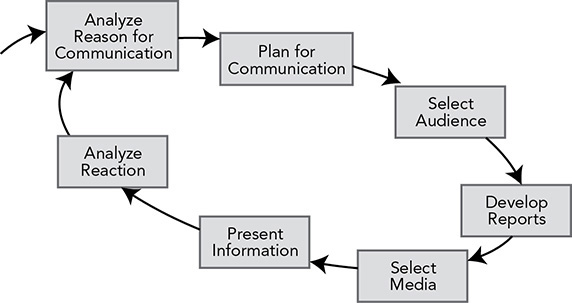
Step 1. Analyze Reason for Communication
As shown in Figure 11.1, the first step involves analyzing the need to communicate the results from a marketing program. Just as it is necessary to explore customer needs before any marketing program, it is important to outline the specific reasons why we need the communication. Do we need more support for our marketing programs? Do we need to maintain or adjust the funding for our programs? Alternatively, do we need to instill confidence among stakeholders or build credibility for our marketing programs? The specific reasons for communicating results will depend on the nature of the marketing program, the setting, and the unique needs of each party.
Step 2. Plan for Communication
To achieve maximum results, we need to carefully plan for communication, which is the focus of the second step. Communication consumes resources, time, and energy. The planning of the communication is important to ensure that each audience receives the proper information at the right time and that necessary actions are taken as expected. Planning should focus on when and to which audience the communication should be presented, the specific types of data to be communicated, and the action items to be addressed. We list several crucial issues in this critical step of planning the communication of results:
• Who is the target audience?
• What will be communicated?
• When will the data be communicated?
• How will the information be communicated?
• Where will the information be communicated?
• Who will communicate the information?
• What are the specific actions required or desired?
Because communication is such an important component of marketing program development and management, we should start to consider the communication plan even before implementing the program.
Step 3. Select Audience
Similar to selecting target segments of customers, the third step involves selecting the target audiences for communication. The reason we should recognize different audiences is that each audience typically has its own needs. We should consider an overall communication strategy for all groups and carefully design and artfully craft delivery of the message for each specific group to fit the needs. We identify several common target audiences and list them in Table 11.1. The figure also briefly discusses the basis for each audience selection.
TABLE 11.1 Common target audiences
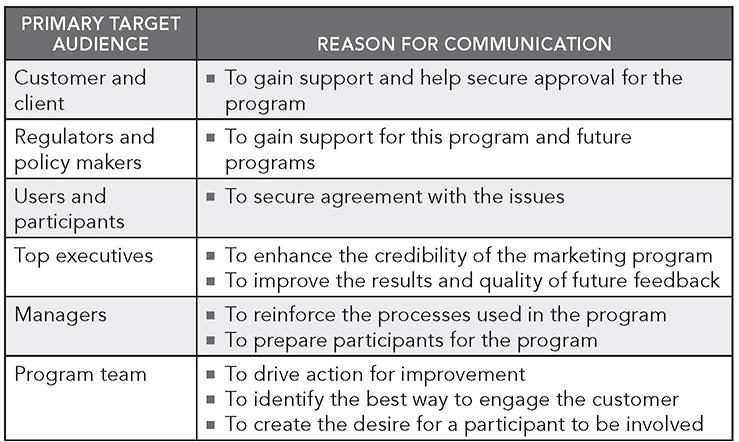
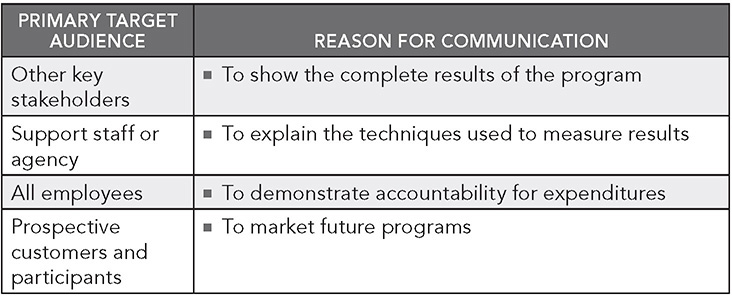
Step 4. Develop Reports
Developing reports is the fourth step of the communication process. This step involves written materials to explain the results of a marketing program to a particular audience group in a format desired and appreciated by that group. It is similar to the product development process of marketing. Depending on the needs of the audience, the written materials can be a brief summary of the results, or they can be detailed research documents on the evaluation process and outcomes. Typically, marketers develop a complete report, select parts or summaries from the report, and use them for different media to serve different communication goals and purposes. We present a possible outline for an impact study report of a marketing program in Box 11.1.
Box 11.1 Outline for an Impact Study Report
1. General information
![]() Background
Background
![]() Objectives of study
Objectives of study
2. Methodology for impact study
![]() Levels of evaluation
Levels of evaluation
![]() ROI process
ROI process
![]() Collecting data
Collecting data
![]() Isolating the effects of the program
Isolating the effects of the program
![]() Converting data to monetary values
Converting data to monetary values
3. Data collection analysis issues
4. Results: General information
![]() Response profile
Response profile
![]() Success with objectives
Success with objectives
5. Results: Reaction
![]() Data sources
Data sources
![]() Key issues
Key issues
6. Results: Learning
![]() Data sources
Data sources
![]() Key issues
Key issues
7. Results: Action
![]() Data sources
Data sources
![]() Key issues
Key issues
8. Results: Impact
![]() Data sources
Data sources
![]() Isolating the effects of the program
Isolating the effects of the program
![]() Key issues
Key issues
9. Results: ROI
![]() Converting data to money
Converting data to money
![]() Project costs
Project costs
![]() ROI and its meaning
ROI and its meaning
10. Results: Intangible measures
11. Barriers and enablers
![]() Barriers
Barriers
![]() Enablers
Enablers
12. Conclusions
13. Recommendations
14. Exhibits
It is important not to boast about the results of a marketing program. Grand claims of overwhelming success can quickly turn off the audience and can be counterproductive for the delivery of the desired message. Further, credit for the success must go to the parties that deserve it, which may be team members, participants, and their managers. For audiences who are not familiar with either the ROI marketing methodology or the marketing program, we should clearly explain the methodology and the program. In contrast, if the audience understands the basic concepts of the ROI marketing methodology or is familiar with the marketing program, then a brief one-page summary may be appropriate. We provide an example of such a one-page summary for a marketing program in Figure 11.2.
Figure 11.2 One-page summary
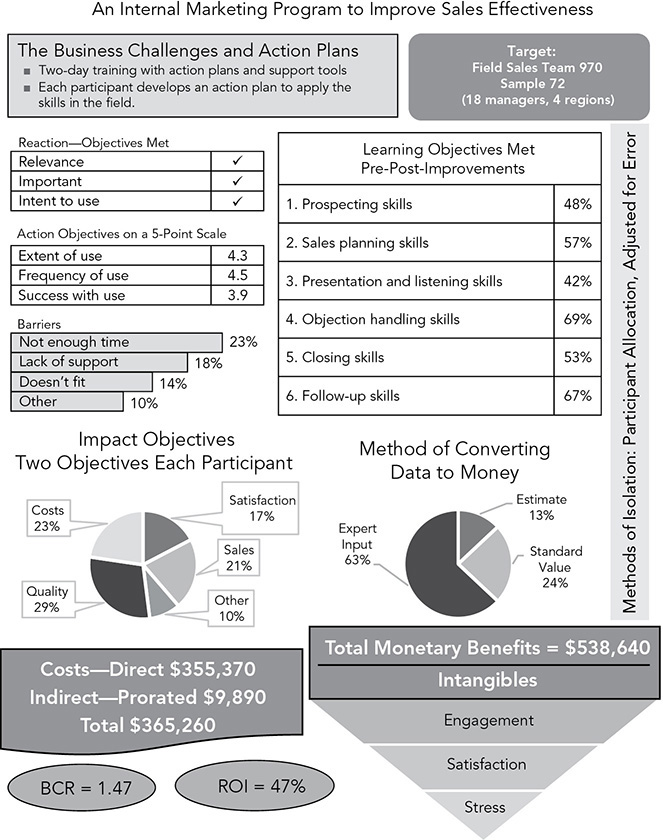
Step 5. Select Media
The fifth step of the communication process is media selection. Choosing certain methods of communication that a target group will respond to favorably is similar to selecting a distribution channel for a target customer segment. Although many options are available for the dissemination of program results, none of them is perfect. These options all have their pros and cons, which make some options more appropriate for certain audience groups than others. We list some common options in Table 11.2.
TABLE 11.2 Communication options
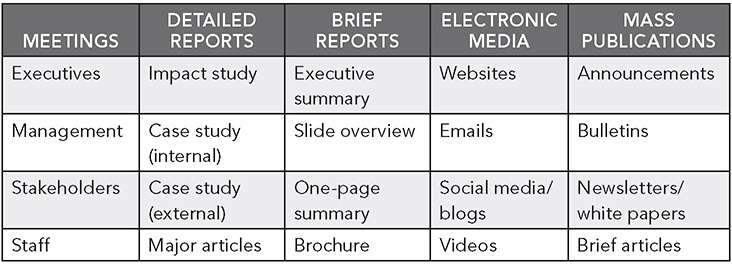
Step 6. Present Information
The sixth step is presenting and delivering the message about the program results in the form of appropriate information. Just as with a successful sales presentation, the key to delivering the message is to understand the audience members and their perspectives and then show what benefits there are for them. Darlene Price, a communications expert, makes the following suggestions for delivering the message:
• Do not try to perfect your communication but try to connect with your audience.
• Organize your presentation with persuasive logic and use an effective structure.
• Ensure the delivery to be dynamic and confident every time with live presentations.
• Engage your audience whenever possible to make the message meaningful and memorable.
• Use PowerPoint more effectively to reinforce your message and to optimize impact.
• Manage nervousness and create a great first impression.
• Cultivate a variety of image enhancers that will subtly lend power to your presentation.2
There are different types of situations, under which we choose appropriate communication forms to present the program results. We discuss three types of communication situations in the following sections.
Presentation of Results by Providing Feedback
For most marketing programs, marketers routinely collect and analyze data at multiple levels. A primary reason for doing so is to provide feedback to various audiences in order to make adjustments and improvements throughout the program. We recommend the following steps for providing feedback and managing the overall process based on the concepts and recommendations of Peter Block in his successful book Flawless Consulting.3
• Communicate quickly.
• Use negative data in a constructive way.
• Use positive data in a cautious way.
• Simplify the data.
• Carefully choose the language of the communication.
• Ask the audience for reactions to the data.
• Ask the audience for recommendations.
• Use support and confrontation carefully.
• Secure agreement from all key stakeholders.
• Keep the feedback process short.
Following these steps does not guarantee success, but it will help move the program forward and generate useful feedback, which will lead to necessary adjustments that are supported and executed.
Presentation of Results by Storytelling
We cannot rely on only numbers and data to tell the whole story. Other means of communication, such as storytelling, are required to define and articulate the results. Storytelling is a uniquely useful technique in its ability to bring people together and to organize and present information in an efficient and accessible manner. Storytelling creates a richer experience and fosters greater insight into the nature of the program, therefore enabling key stakeholders to understand how the marketing program contributes to organizational success.4
There are empirical evidence and compelling reasons why storytelling works, as discussed by Paul Smith. We summarize them into the following:
1. Storytelling is simple.
2. Storytelling is timeless.
3. Stories are contagious.
4. Stories are easier to remember.
5. Stories inspire.
6. Stories appeal to all types of audiences.
7. Stories fit in the workplace where most of the work happens.
8. Telling stories shows respect for the audience.5
It is helpful to have a logical structure when developing a story. Box 11.2 presents a checklist for developing stories effectively and efficiently. The checklist includes the major components of a story structure, although the structure may vary depending on the audience and situation.
Box 11.2 Story Structure Checklist
Hook
![]() Why should I listen to this story?
Why should I listen to this story?
Content
![]() Where and when did it happen?
Where and when did it happen?
![]() Who is the hero? (Is the hero relatable?)
Who is the hero? (Is the hero relatable?)
![]() What does the hero want? (Is that worthy?)
What does the hero want? (Is that worthy?)
Challenge
![]() What is the problem/opportunity? (Relevant?)
What is the problem/opportunity? (Relevant?)
Conflict1
![]() What did the hero do about it? (Honest struggle?)
What did the hero do about it? (Honest struggle?)
Resolution
![]() How did it turn out in the end?
How did it turn out in the end?
Lesson
![]() What did you learn?
What did you learn?
Recommended Action
![]() What do you want me to do?
What do you want me to do?
Presentation of Results to Senior Management
The third type, and probably the most challenging and stressful type of communication, is presenting the results of a marketing program to senior management. For many marketing programs, senior managers are the sponsors, supporters, and, sometimes, the clients. The challenge is convincing this highly skeptical and critical group that we have achieved outstanding results in a very reasonable time frame. We need to not only address the performance issues but also make sure that the top managers understand the process. We have several guidelines to help ensure that we plan and execute this process properly, which are shown in Box 11.3.
Box 11.3 Guidelines for the Executive Meeting
Purpose of the meeting:
![]() Create awareness and understanding of ROI.
Create awareness and understanding of ROI.
![]() Build support for the ROI Methodology.
Build support for the ROI Methodology.
![]() Communicate the results of the study.
Communicate the results of the study.
![]() Drive improvement from the results.
Drive improvement from the results.
![]() Cultivate the effective use of the ROI Methodology.
Cultivate the effective use of the ROI Methodology.
Use these ground rules:
![]() Do not distribute the impact study until the end of the meeting.
Do not distribute the impact study until the end of the meeting.
![]() Be precise and to the point.
Be precise and to the point.
![]() Avoid jargon and unfamiliar terms.
Avoid jargon and unfamiliar terms.
![]() Spend less time on the lower levels of evaluation data.
Spend less time on the lower levels of evaluation data.
![]() Present the data with a strategy in mind.
Present the data with a strategy in mind.
Follow this presentation sequence:
1. Describe the program and explain why it is being evaluated.
2. Present the methodology process.
3. Present the reaction and learning data.
4. Present the action data.
5. List the barriers to and enablers of success.
6. Address the business impact.
7. Show the costs.
8. Present the ROI.
9. Show the intangibles.
10. Review the credibility of the data.
12. Summarize the conclusions.
13. Present the recommendations.
Step 7. Analyze Reaction
The seventh step is analyzing the audience’s reactions to the communication efforts. When we communicate the results of our marketing programs, we should monitor the reactions of the target audience. These reactions include verbal remarks, written comments, nonverbal gestures, and other actions that may reveal how the audience received and perceived the messages. We may collect the reaction data in various ways. For example, when we present the results face-to-face in a meeting, we may have some indication about how the group reacts to our presentations by observing people’s facial expressions, by listening to their comments, and by answering their questions. When we communicate major program results, we may use a feedback questionnaire to determine the extent to which the audience understood and believed the information presented. The survey can be administered to the entire audience or a sample of the audience. We can also evaluate the interest and attitudes of the audience members online by reading the comments they make to social media posts or replies to our emails. Comments about the results, both online and offline, should be noted and tabulated.
For many situations, the analysis can be informal. For communication efforts that are extensive and more involved, we may need a formal and structured feedback process. However, monitoring reactions is not where the effort ends. Depending on the nature of these reactions, we can adjust our subsequent strategies for better communication of the program results. The reaction data can also be used for adapting future program communications. A more important measure of the effectiveness of our communication effort is the extent of commitment and support attained from the managers, executives, and sponsors. The allocation of more resources and voiced commitment from top management are strong evidence of management’s positive perception of our communication of the results.
Final Thoughts
Communicating results is a crucial step for the success of a marketing program. We need to execute our communications properly and adequately in order to demonstrate the value of the marketing program, establish credibility, and win more support, resources, and funding. We started the chapter with a discussion about the importance of communication, guidelines, and general principles. These general principles are vital to the overall success of the communication effort. We then introduced a seven-step approach for communicating program results and showed the importance of inducing desirable behaviors in the target audience to accomplish our communication goals.
This chapter highlighted the importance of communicating all results, whether they are positive or negative. If the results are not satisfactory as expected, the communication will lead to the necessary adjustments for performance improvement. In the next chapter, we will discuss the topic of optimizing the results, the last step of the 12-step ROI Methodology.
